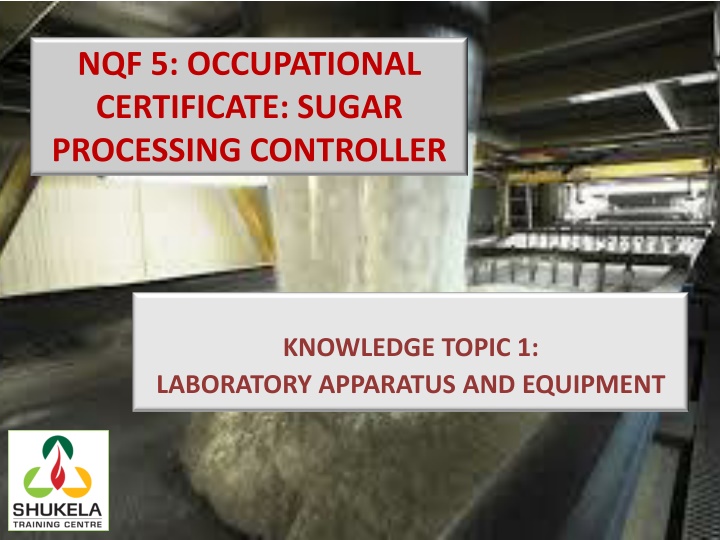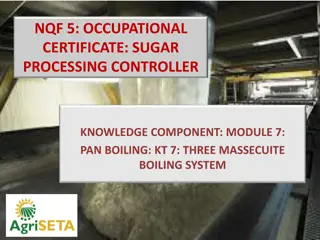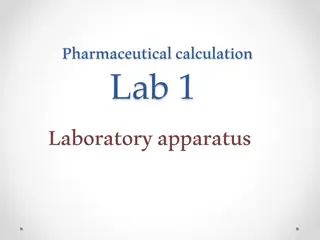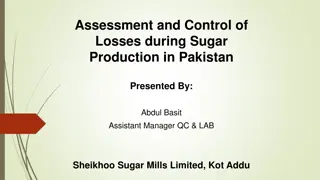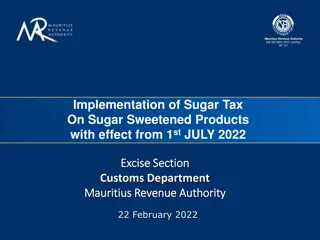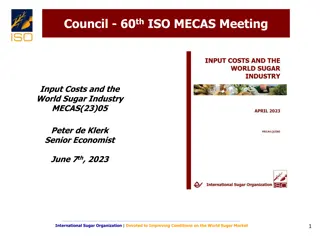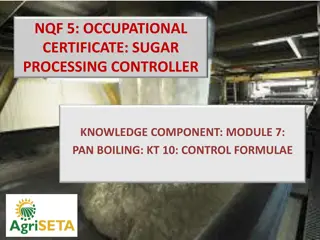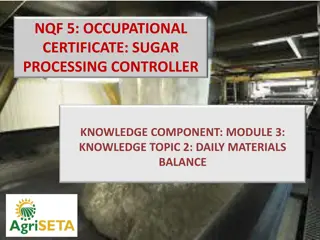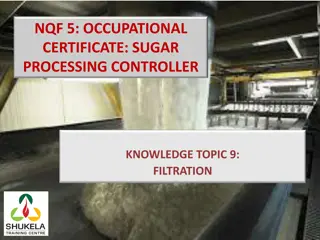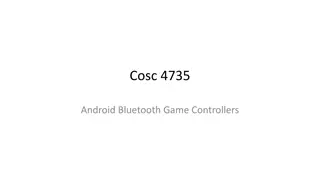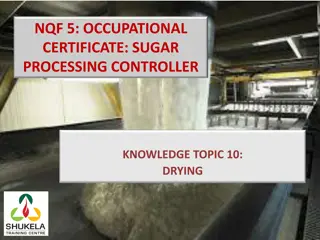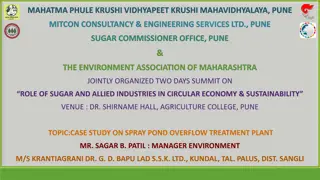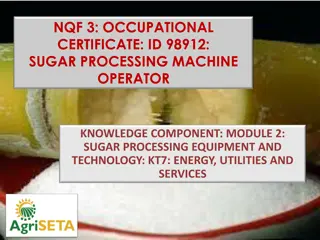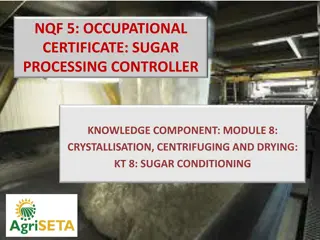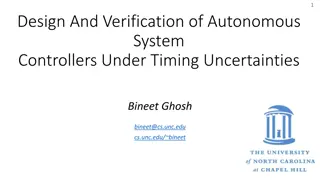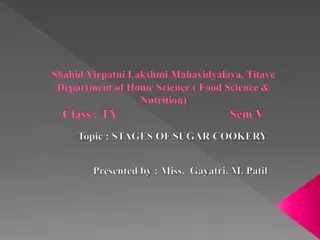Essential Laboratory Apparatus and Equipment for Sugar Processing Controllers
The analytical results obtained from the laboratory play a crucial role in ensuring the smooth and effective functioning of sugar extraction and processing operations. Understanding and utilizing laboratory apparatus and equipment are key aspects of the Sugar Processing Controller's role, enabling them to make informed decisions based on accurate data and maintain high standards in sugar production.
Download Presentation

Please find below an Image/Link to download the presentation.
The content on the website is provided AS IS for your information and personal use only. It may not be sold, licensed, or shared on other websites without obtaining consent from the author.If you encounter any issues during the download, it is possible that the publisher has removed the file from their server.
You are allowed to download the files provided on this website for personal or commercial use, subject to the condition that they are used lawfully. All files are the property of their respective owners.
The content on the website is provided AS IS for your information and personal use only. It may not be sold, licensed, or shared on other websites without obtaining consent from the author.
E N D
Presentation Transcript
NQF 5: OCCUPATIONAL CERTIFICATE: SUGAR PROCESSING CONTROLLER KNOWLEDGE TOPIC 1: LABORATORY APPARATUS AND EQUIPMENT
Introduction The analytical results from the laboratory are essential for the efficient operation of the sugar extraction and recovery processes. It is therefore critical that the laboratory results are accurate. The laboratory worker/ analyst thus has a very important and responsible task. It is important that the laboratory worker knows the names and the uses of all the equipment at his disposal. This gives him a better understanding of his work and ensures that he uses his equipment correctly. Correct use of equipment plays an important role in achieving accurate analytical results.
Beaker tongs Used to handle hot beakers safely.
Beaker These are cylindrical in shape and have a spout to enable liquid to be poured without spilling. Beakers are used for mixing, boiling, supporting a funnel and numerous other uses. The volume of a beaker can be expressed to millilitres (ml) or cubic centimetres (cm3or cc) with 1 millilitre being equal to 1 cubic centimetre. We will use beakers of volume 50ml, 250ml and 600ml. Note: The volume graduations on beakers may only be used to collect or disperse approximate volumes.
Buchner Funnel Used to hold the filter paper when filtering under vacuum. Their sizes are indicated by their inner diameter i.e. 70mm, 85mm etc.
Bulb Pipette These are a type of volumetric glassware. Volumetric glassware refers to glassware that is accurately marked to hold or deliver exact volumes under specified conditions. A pipette is a volumetric vessel used to deliver a constant volume of liquid according to the size of the pipette. We will use bulb pipettes of volumes 100 cm ; 50 cm ; 25 cm ; 20 cm ; 10 cm ; 5 cm ; 2 cm ; 1 cm . Note: A pipette will only be accurate when both the pipette and the liquid inside the pipette are at the temperature marked on the pipette.
Bunsen Burner A Bunsen burner uses propane and butane gas (LPG) to produce an intense flame. Glassware is usually not heated directly by the Bunsen but the glassware is placed on a wire gauze. However, during ashing the crucible is heated directly by the Bunsen burner.
Burette A long volumetric cylinder used in titrations for accurately dispensing quantities of liquid between 0 and 50 cm3. When not in use a burette must be clamped upside down with the tap open and the bottom end of the burette clear from the stand.
Burette Brush A long thin brush used for cleaning burettes.
Burette Stand This stand is used to hold a burette in an upright position. It can also be used to clamp other apparatus and is sometimes called a retort stand.
Burette Clamp A clamp used to hold the burette upright on a retort stand.
Burette filling funnel A small funnel used when filling a burette with liquid.
Bosshead Used to attach a clamp to a stand. A bosshead must be attached to the retort stand in such a way that it supports the clamp even if the clamp is not firmly held by the screw of the bosshead.
Clamp Used to clamp (hold) glassware to a stand.
Cookie Jar A plastic container used when tumbling cane for preparation index determination. They can also be used to store samples.
Cork borer These come in different sizes (diameters) and are used to make holes in corks or rubber bungs for fitting glass tubing.
Crucible A vessel used when heating a sample to a high temperature during ashing . Crucibles are usually made from porcelain which will withstand high temperatures.
Crucible tongs Used to remove crucibles from the Bunsen or muffle furnace.
Decanting Stand Used to hold a sieve steady when pouring samples of juices and extracts through it.
Desiccator Used to cool objects in a dry atmosphere
Digestor Bowl The bowl that fits onto the cold digestor and which contains water and the sample of prepared cane that is to be disintegrated.
Dripping bottles Used for adding indicator solutions dropwise.
Erlenmeyer Flask/Conical Flask A general purpose flask that can be heated and is used extensively during titrations. These flasks have graduations to give a rough indication of the volume of liquid contained.
Evaporating Basin Used on the steam bath (water bath) to evaporate solutions to dryness.
Filter Paper Used to separate solids from liquids. The liquid travels through the paper leaving the solids behind. The liquid (or solution) that goes through is called the filtrate, while the solids left behind on the paper is known as the residue.
Filter Flask / Buchner Flask Used to support the Buchner funnel and to catch the filtrate when doing vacuum filtrations. In order to withstand pressure variations these filter flasks are made from thicker glass than ordinary Erlenmeyer flasks. We will use 250cm3 and 500cm3 filter flasks.
Flask tongs Used to handle hot flasks safely.
Funnel Used to support filter paper during filtration or for pouring liquids into narrow- mouthed containers.
Furnace tongs Used when removing hot items from the muffle furnace.
Glass Beads Some glass beads placed into a boiling liquid will promote even boiling and prevent bumping
Glass bottles / Sample bottles Used for mixing and storing samples.
Graduated Pipette A volumetric vessel used to deliver liquid according to the graduation on the pipette. We will use graduated pipettes of maximum volume 25 cm , 10 cm and 5 cm .
Kohlrausch Flask A wide-mouthed volumetric flask used for the preparation of solutions of filter cake and sugar pol. It is useful for applications where it is difficult to get solids into the narrow neck of an ordinary volumetric flask. Kohlrausch flasks are rarely used for pol determinations. Sugar flasks are preferred. These are similar to Kohlrausch flasks, but the neck is not as wide. We use 100 ml sugar flasks for sugar pol determinations.
Large Massing Basin Used when massing (weighing) bagasse or cane samples.
Magnetic Follower Used with a magnetic stirrer hot plate to mix the contents of a beaker or flask. It consists of a small metal bar covered in plastic. Sometimes magnetic stirrers are also fitted to hot plates.
Magnetic Follower Retriever Used to take the magnetic follower out of a beaker or flask.
Measuring Cylinder Used for measuring out liquids or solutions. Measuring cylinders are more accurate than beakers but not as accurate as pipettes or burettes (i.e. volumetric glassware).
Moisture Dish Used to hold sugar when drying sugar in an oven for moisture determination. It consists of a stainless steel dish with a cover / lid.
Mortar and Pestle Used to grind samples or chemicals to smaller pieces or into a powder form.
Nickel Massing Basin Used for general massing (weighing) of small quantities. It has a wide top with a spout to facilitate transferring its contents into another container.
Pinch Clips Used to clamp rubber tubing to act as a valve / seal.
Pipette Filler Used when filling a pipette with dangerous / toxic liquids. When in any doubt as to the nature of a liquid or solution, consider it as dangerous and use a pipette filler.
Pipette Stand Used for storage of pipettes.
Plastic Jug Used when massing (weighing) water or measuring out approximate quantities of water.
Policeman A plastic or rubber sleeve that fits over a glass stirring rod and prevents chipping and other damage.
Protective Mask To be used to protect the face and eyes against flying glass should there be the risk of explosion or implosion of glass.
Quick Fit Erlenmeyer Flask These are cylindrical in shape and have a spout to enable liquid to be poured without spilling. Beakers are used for mixing, boiling, supporting a funnel and numerous other uses. The volume of a beaker can be expressed to millilitres (ml) or cubic centimetres (cm3or cc) with 1 millilitre being equal to 1 cubic centimetre. We will use beakers of volume 50ml, 250ml and 600ml. Note: The volume graduations on beakers may only be used to collect or disperse approximate volumes.
Reagent Bottle Used to store chemicals and solutions. They must have tight fitting tops either plastic or glass. Screw tops are not acceptable.
Reflux Condenser / Liebig Condenser This apparatus fits snugly onto a quick-fit flask and is used to condense the vapour being released by the boiling solution in the flask. Its operation is very simple. Vapour moves up the central glass tube of the condenser, which is surrounded by cooling water drawn from a tap. The water enters at the bottom, swirls around the outer glass tube and exits at the top. Sometimes the cooling water flows through a coil in the centre of the condenser and the vapour is outside.
Rubber Cone Used when connecting a filter flask and Buchner funnel to provide a vacuum seal. The rubber cone fits into the neck of the Buchner flask.
